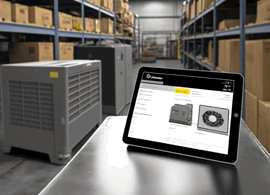IoT and AI integration creates unique benefits for businesses by enabling real-time, smart inventory management and automation. IoT sensors, electronic tags for assets and inventory (such as BLE and RFID), and smart cameras can continuously capture data on inventory location, condition, and usage. AI algorithms process and analyze this data to detect patterns, predict demand, and automate restocking, helping businesses to optimize stock and utilize assets efficiently. Together, IoT and AI improve accuracy, reduce manual work, and enhance responsiveness to supply chain changes, leading to efficient and cost-effective inventory management / asset tracking systems.
Inventory Management Trends, From Logbooks To AI And IoT
Inventory management process has come a long way from manual logbooks and periodic stock-taking. Traditional inventory methods often relied on pen-and-paper tracking. Today they have moved to computer-based systems. However, even more recent digital inventory systems frequently feel inadequate in keeping up with the modern complex supply chains. Demand for the efficient, accurate, smart inventory management system grows along with the business. Advanced technologies like Artificial Intelligence (AI) and the Internet of Things (IoT) are transforming the way you manage stock and track assets, by bringing automation, precision, and real-time visibility into the old task of managing inventory.
Understanding The Basics: AI & IoT Technologies
To understand how AI and IoT can improve inventory management and asset tracking process, it is important to understand what each technology entails and how they work together to provide intelligent solutions.Role Of IoT In Asset Tracking & Inventory Management
IoT (Internet of Things) refers to a network of wirelessly connected physical devices. Devices in the IoT network are connected to the internet, directly or via a gateway. This connectivity allows IoT devices to collect on site data and send it over to the cloud platform. IoT devices used for inventory and asset management include Bluetooth Low Energy (BLE) tags and gateways, RFID tags, GPS trackers, cameras, temperature sensors, and smart shelves. These devices capture a range of real-time information about assets and inventory. For instance, RFID tags and barcode scanners track the movement and quantity of products across warehouses, while temperature sensors can monitor conditions in refrigerated storage. This continuous flow of data provides you with real-time visibility into the inventory and assets status.Role Of AI In Inventory Management
AI (Artificial Intelligence) is a modern technology that enables computers to think and learn like humans. AI is made up of many different components, each handling its own specific set of tasks. For inventory management, AI components such as machine learning and predictive analytics are used to process and analyze data collected by humans or IoT devices.AI algorithms are great at recognizing patterns, generating predictions, and automating decisions based on large datasets. AI based inventory system can also flag anomalies, such as sudden drops in inventory levels that might indicate misplacement or theft.
Analytical reports provided by AI-powered inventory management systems directly support inventory decisions, from purchase planning and asset utilization to optimizing inventory stock.
How IoT and AI Complement Each Other.
The natural synergy between IoT and AI is what makes this technology duo so powerful in the context of inventory management and asset tracking. IoT provides the data, and AI transforms that data into meaningful, actionable insights. Here is how they complement each other in practical terms:Real-Time Data and Immediate Action
IoT devices continuously stream live data from warehouses, store shelves, and vehicles. AI-powered inventory system processes this data in real time, allowing inventory managers to make fast decisions based on current inventory levels, location, and movement patterns. For instance, if an IoT sensor detects a stock level dip, AI algorithms can trigger an automated reorder, ensuring that items remain in stock without human intervention.Enhanced Accuracy of Inventory Forecasts
The longer AI models work, the more accurate they become, as they learn quickly and adjust predictions based on new patterns or seasonal fluctuations in demand. For example, using data from IoT-enabled shelves and POS (point-of-sale) systems, AI can predict when certain products are likely to run low and proactively initiate restocking.Inventory Optimization and Automation
Combining IoT real-time data collection with AI processing power allows you to optimize inventory efficiently. Large companies can use IoT sensors in smart warehouses to monitor stock across different sections and direct AI-driven robots to manage the movement of items for optimal storage. If you are a small or medium business and robot-equipped smart warehouses are an overkill, AI is still helpful. AI algorithms can analyze usage and sales trends to recommend inventory adjustments, reduce holding costs, and improve product availability across distribution channels. The result is a more responsive and lean inventory system that adapts to changing conditions and minimizes waste.
Together, IoT and AI enable a smarter, more automated approach to inventory management, one that can adapt to the changing supply and demand. The IoT sensors serve as the "eyes and ears" of the system, while AI acts as the "brain," processing the data and executing decisions in real time. This combination transforms traditional inventory management into a dynamic, data-driven system.
How Integrated IoT and AI Systems Solve Inventory Management Challenges
Businesses face many inventory management challenges that can impact efficiency, customer satisfaction, and profitability. Below are some of the most pressing pain points and how AI and IoT technologies are helping to address them effectively.Problem: Inventory Tracking Errors
When employees manually move items around a warehouse or a shop, or take out tools and equipment, they may forget to scan them and log updates. This leads to “phantom inventory” situations, where items appear to be available but are actually misplaced or in an incorrect location. Such errors disrupt the entire business, making it impossible to locate items and resulting in inaccurate stock levels, project delays and wasted time.→
AI & Iot Solution: Automated Asset & Inventory Tracking
Electronic tags and IoT gateways track inventory and asset movements automatically, reducing dependency on human intervention. For example, in the BLE asset tracking system IoT gateways receive signals from BLE tags every few minutes, accurately recording asset location and inventory stock.AI algorithms can detect misplaced assets or irregularities in the inventory stock patterns, and send you immediate alerts.
Problem:Outdated Data
Traditional inventory systems often rely on manual or periodic updates, which can lead to discrepancies between recorded and actual stock levels. Lack of real-time visibility can result in errors in inventory counts, delays in restocking, and limited view into the true state of inventory.→
AI & IoT Solution: Real-Time Inventory Visibility
IoT asset tracking system provides real-time data on assets location, inventory stock level and movement. By continuously scanning for tagged items and updating the central database, IoT tracking offers up-to-the-minute assets and inventory status in all locations.Problem: No Way To Predict Demand
Demand forecasting is critical but challenging. It is influenced by multiple factors from seasonal trends to promotions. It also depends on shifting consumer preferences. Relying solely on historical sales data can often lead to inaccurate forecasts.→
AI & IoT Solution: Accurate Demand Forecasting
AI algorithms use historical data, data collected by IoT devices, and external factors (like seasonal trends and market behavior) to make an accurate demand forecast. By analyzing large datasets and recognizing patterns, AI-powered inventory system can forecast demand with higher accuracy than traditional methods.Problem: Inventory Stockouts and Overstock
With manual, inaccurate inventory tracking inventory shortages and overstocking is a common problem. If the company does not know what inventory it has in stock, it can easily run out of inventory when it is needed the most, or order inventory that is "lost" somewhere in the warehouse. Both have negative effects on business operations and bottom line.→
AI & IoT Solution: Optimized Inventory Stock
AI-powered inventory system can calculate optimal stock levels based on real-time sales data, current inventory levels, and demand forecasts, helping to prevent both stockouts and excess inventory. Additionally, automated reordering systems can be triggered by IoT data, ensuring stock levels are maintained without manual intervention.Problem: Poor Warehouse Organization
Optimizing warehouse storage space is another pain point. Without a smart inventory system that can analyze inventory deliveries, picking and shipping patterns it is hard to come up with the most efficient warehouse configuration. Inefficient storage causes fulfillment delays and increased operational costs.→
AI & IoT Solution: Efficient Warehouse Management
IoT and AI work together to optimize warehouse operations by guiding storage, retrieval, and movement of inventory within warehouses. IoT devices track the location and status of goods in real time, while AI algorithms analyze space utilization and suggest optimal storage layouts.
Using IoT And AI Integration For Efficient Inventory Management: Case Studies
Many businesses are already integrating IoT and AI combo in their inventory management process, achieving unprecedented levels of efficiency, accuracy, and cost savings.Real-Time Inventory Monitoring: Amazon
Amazon has set the standard for real-time inventory monitoring in its massive fulfillment centers. Using IoT and AI-driven robotics, Amazon warehouses track the location and status of millions of items in real time. IoT is used for real-time inventory monitoring, while AI algorithms determine the most efficient storage and retrieval methods. This combination allows Amazon to keep stock levels optimized and fulfill orders rapidly.
Automated Demand Forecasting: Walmart
Walmart uses AI-driven demand forecasting to manage its massive supply chain and inventory across thousands of stores. By analyzing vast datasets, AI models predict product demand down to the store level, enabling proactive restocking and reducing the likelihood of stockouts. This approach also minimizes overstock, freeing up valuable shelf space and improving profitability across Walmart stores network.Efficient Warehouse Management: Zebra Technologies
Zebra Technologies, a company specializing in warehouse automation, has implemented integrated AI and IoT solutions for businesses to improve efficiency. Their smart shelves, RFID tags, and robots enable real-time tracking and autonomous item retrieval, significantly reducing the time needed for order fulfillment. This setup has allowed companies to improve efficiency, reduce labor costs, and create well organized, responsive warehouses.
Enhanced Inventory Security and Loss Prevention: Target & 570 Logistics
Target
Target uses IoT and AI technology to improve inventory security across its retail locations and distribution centers. Motion detectors, RFID sensors, and security cameras monitor items and identify discrepancies in stock levels or unauthorized access. AI systems analyze this data for irregular patterns, helping to prevent losses due to theft or mishandling. As a result, Target has been able to reduce losses significantly while improving the accuracy of its inventory management.570 Logistics
570 Logistics is a company that subcontracts "last mile delivery" for companies like FedEx. The company uses BLE asset tracking system to curtail loss and theft of expensive hand-held computers. After implementing the system about one year ago, they didn't have a single computer "disappear", while before implementing BLE-based asset tracking they used to average one lost device per month.You can find more info on 570 Logistics case study here.
Loss Prevention: IoT Contribution
IoT cameras, sensors, and BLE or RFID tags can monitor inventory locations, detect unauthorized movement, and identify environmental risks. For example, temperature sensors can protect perishable items by ensuring they remain within safe storage conditions. Smart cameras and motion sensors can detect unusual activity, such as unauthorized access to certain areas.Loss Prevention: AI Contribution
AI algorithms analyze security data from IoT devices to recognize patterns that may indicate theft, spoilage, or mishandling. AI can distinguish between regular and suspicious behavior, triggering alerts in real time if it detects potential security threats. Additionally, AI can conduct trend analysis to highlight patterns in product loss, enabling companies to address systemic issues in security.AI and IoT combination is already providing a lot of benefits to the companies who are using these advanced technologies in their inventory management process. As AI and IoT continue to evolve, their applications in inventory management will grow and become even more advanced, offering businesses unprecedented levels of efficiency, precision, and automation. Read second part of this article that discusses benefits and future trends of IoT and AI in inventory management.
Are you currently using IoT and AI in your inventory management processes? What challenges or successes have you experienced? We'd love to hear about your experiences, questions, or thoughts on how these technologies are reshaping the way we manage inventory. Feel free to share your insights or reach out if you have any questions about implementing IoT and AI solutions in your business. Together, we can explore how the future of inventory management will continue to evolve!
